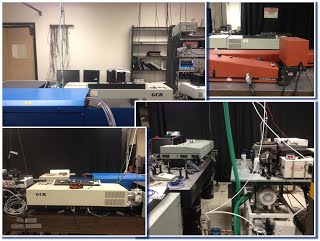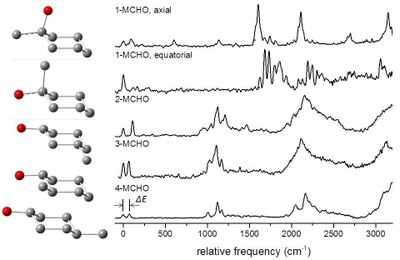The High-resolution Spectroscopy Lab

The free radicals that we study are generated in a supersonic free jet expansion by either laser photolysis or pulsed electric discharge of precursors. The species so generated are cooled to ~1K in the expansion. A second laser (a Continuum OPO or a Sirah dye laser) "pumps" the molecules to upper electronic states and is tuned to scan the excited state energy levels. In the laser-induced fluorescence (LIF) experiment, the total fluorescence associated with the decay of the excited states is detected. In the dispersed fluoresce experiment, different components of the fluorescence, corresponding to different energy levels of the lower electronic states, are dispersed and detected. A third laser can be used to "dump" the excited state population to the lower states in the so-called "stimulated emission pumping" (SEP) experiment, which gives better-resolved ground state energy level structure.
The second spectroscopic technique that is employed by our research group for the detection and characterization of free radicals is cavity ring-down spectroscopy (CRDS). It is a highly sensitive laser spectroscopic technique that is able to measure absolute absorption cross sections. CRDS measures the exponential decay of light intensity leaking from a high-finesse optical cavity. The time constants of such decay when the cavity is empty and is filled with absorbing species are used to determine the absorption coefficient of the absorber. The effective path length can be as long as tens of kilometers. Thanks to the long path length, a minimum detectable absorption coefficient of <1 ppm per pass can be achieved. Two CRDS systems have been built in our lab: a room-temperature setup and a jet-cooled one.
Read More:

